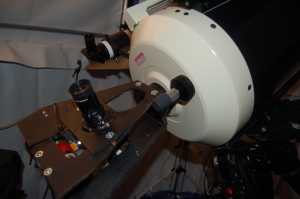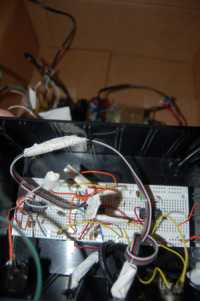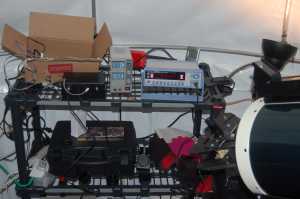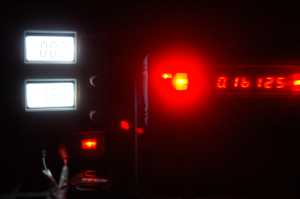Copyright 2008 Starry Mirror



The
TM
Astronomy From West Virginia
A HOME-MADE PHOTON COUNTER WITH RCA 1P21 VACUUM TUBE
BRIDGEPORT, WV (S-M) - We have been experimenting in our observatory with a home-made photon counter.
A photon counter is one of the handiest things one can have in an observatory. Although some folks seem to think of astronomical research as being done by astronomers looking through a telescope or at least taking pretty photographs, in reality almost everything of value is done by various detectors which allow exact measurements to be made. The photometer is the most useful of these devices, because besides measuring magnitudes of stars, it also allows color indexes to be measured by taking readings through various filters. The color indexes are the basis for much of what is known about real stars in our sky.
Among photometers, there are two basic types - the DC photometers, which measure current from the detector, and the photon counters, which actually count photon hits on the detector. Although both kinds can give useful data, the photon counter has a higher signal to noise ratio. In fact, if the detector is cooled with dry ice, the photon counter is so sensitive that it can measure the hit of a single photon.
Another consideration is the detector to be used in the device. The vacuum tube is by far the superior choice. Although a solid state photo diode will work, it has no internal gain and an external amplifier must be used, which adds noise. In contrast, in a vacuum tube, the electrons which are generated by a photon strike are bounced around on a series of plates, each of which has a potential lower than the one in the line before it. This provides a gain in the tube of several million times, and this gain is nearly noise free.
Our tube is an RCA 1P21 photomultiplier tube. It runs on 950 volts DC, provided by a Cockcroft-Wheaton multiplier which is intalled in the photometer head, eliminating HT wiring. The multiplier is fed by a tattoo-machine power supply. A 15V line is fed into the transformer, and another line is peeled off of this 15V line and is run through a potentiometer in order to set the program voltage line into the multiplier. The program line controls the final voltage at a 1:100 ratio, and by setting it at 9.5V, we get the desired voltage in the tube. When on a bright object, the current draw on the 15V line is only about 5ma.
The optical train consists of a diaphragm which blocks light from all but the target object, a flip mirror to allow centering the object, a DCX lens to spread the starlight to a size of 1/8 inch on the photocathode in the tube, and a filter slider. Since we made the body rather crudely of wood, all parts are made so that they can be moved around, and then clamped in position once alignment is found.
The photon counting electronics consist of a pulse conditioner and its custom +5/-5/+11VDC power supply, both home-made. There are some obsolete integrated circuits on the breadboard which serve to filter out thermionic noise and to parse the pulses so that they can be read by the frequency counter. There is a potentiometer in the circuit which controls the low voltage half of a frequency comparator. The sets the voltage at which signals will be rejected, thus acting as a low-end filter. Since we are not supercooling our vacuum tube, there is some dark current and other ambient noise present. Actually, we were surprised that the pulse conditioner worked at all when built on a breadboard!
Once signal from the tube passes through the pulse conditioner, it is counted by a cheap Chinese-made frequency counter. And so, the photons which left a star hundreds or thousands of years ago have finished their journey as a LED readout on the screen attached to our home-made photon counter!
The first night out, we were able to get what looked like good counts on Capella. The counter can be set for different count times, and we were using the one second setting. Each count is a little different due to atmospheric variations, and to determine a magitude, you must take many counts from the subject and a reference star, as well as a patch of empty background sky. Once several dozen counts are made of each star in the set, the magnitudes can be determined statistically. It is not possible for the instrument to give a direct readout of magnitude, at least so long as it is under the Earth's atmosphere. - GW




The head of the photon counter is mounted on a 10" Cassegrain telescope.
The pulse conditioner is shown, with its power supply in the background. Output from the vacuum tube is run through this pulse conditioner, and then to a frequency counter.
On the top shelf, the pulse conditioner is on the left with its power supply in the cardboard box. The frequency counter is on the right, with the tattoo machine power supply in the middle.
Counts are displayed on the frequency counter on the right while voltage and current into the high voltage transformer is measured on the left. Current flow goes up noticably when a light source is directed onto the vacuum tube.